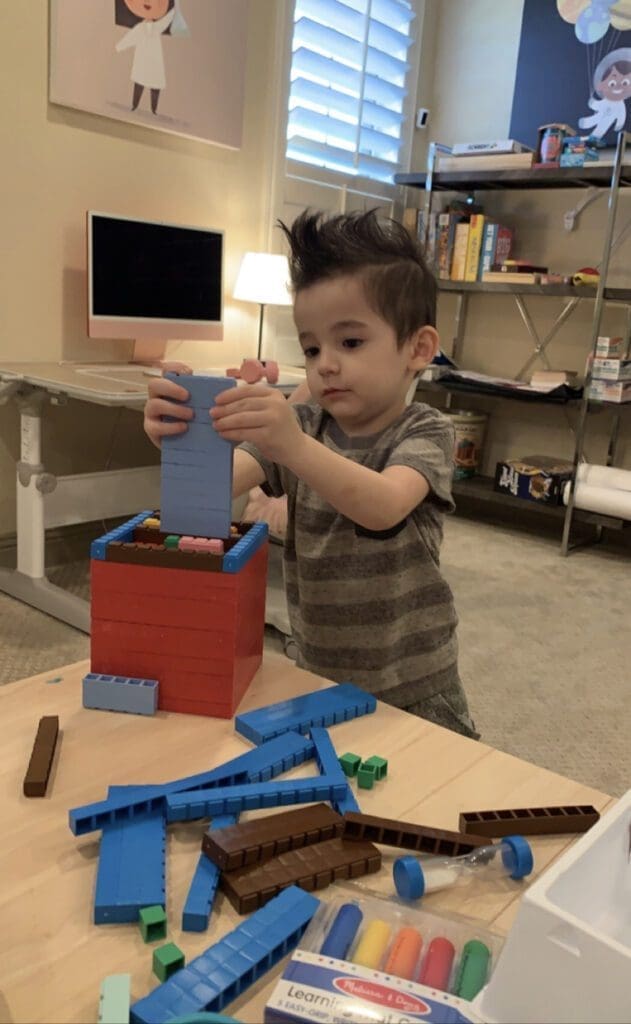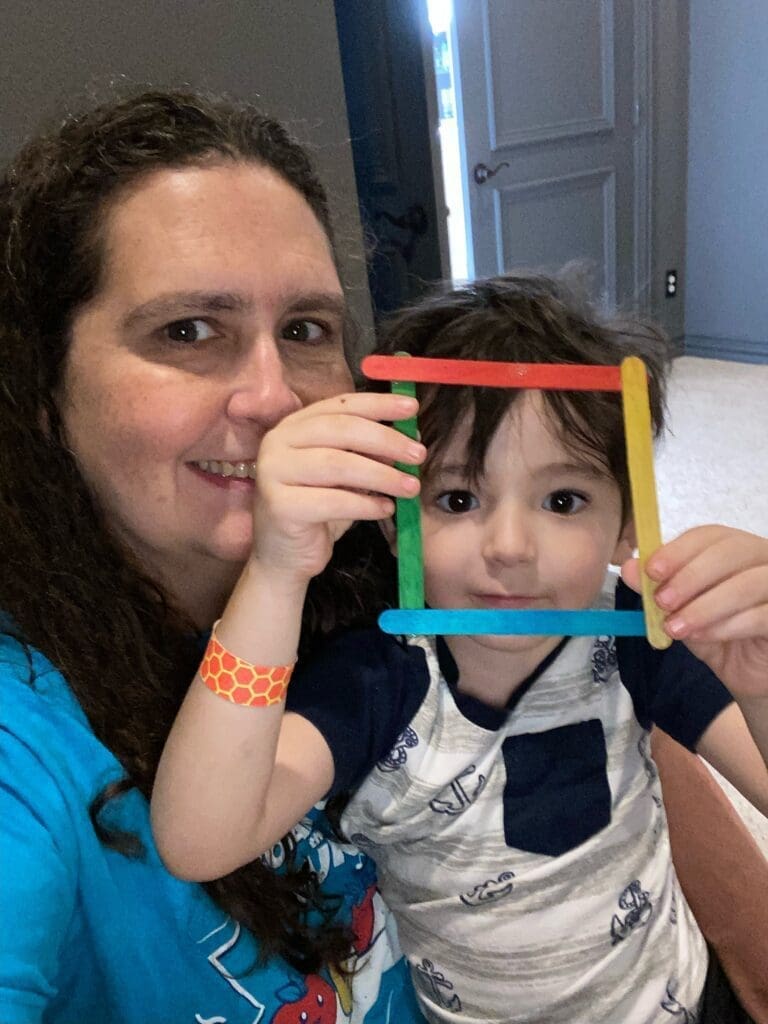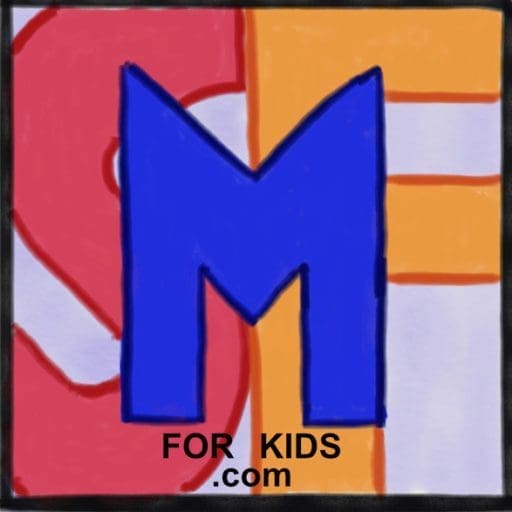
Many parents are looking for options for homeschooling kindergarten math without having their child be on a screen all day.
Although there are many curriculums available you really don’t need an expensive curriculum for kindergarten math. You also don’t need workbooks. (If you do want to purchase a curriculum I have a post on homeschool math curriculums here. And if you are going to choose Right Start math, I might go ahead and suggest Level A for kindergarten.)
Here are the ways I teach kindergarten math in a hands on way. My goal is to develop number sense, mathematical thinking, a foundation for math skills, and, most importantly, a child’s love for math and confidence in their own abilities.
Hands On Math for Kindergarten
Numbers
- Do lots of counting different objects, making sure you touch each object as you count. Teach the child that the last number counted is the amount of the set. Count both forwards and backwards (to 20 to meet school expectations, but most kids will be able to go higher).
- Use your counted objects to figure out 1 more and 1 less.
- Build number sense, starting to 5 and then going to 10 and 20. Use 10 frames such as these to build numbers. There are many versions- magnetic ten frames, large floor mat ten frames, etc. I have and use the rekenrek ten frame to build the connection with the rekenrek mentioned in the next bullet point.
- Use a rekenrek (see my post on what these are and how to use them.)

- Build numbers in many ways using lots of different objects, including unifix cubes, counters, manipulatives, ten frames, rekenreks. Then draw the numbers in different ways. You want your child to be able to identify, write, and represent numbers through at least 20.
- Make up simple addition and subtraction story problems to go with the numbers. “I had 4 cookies, my sister gave me 2. How many cookies do I have?” Use counters or the rekenrek to show the answer. Have your child make up problems for you to solve.
- Make a number path or life size number line and act out addition and subtraction. Teach subtraction as difference between two numbers, not just take away.
- After children have practice grouping numbers in tens (with ten frames, rekenreks, etc) teach them to count by tens.
- Do lots of subsitizing (recognizing groups of numbers in different ways without counting.) Tiny Polka Dot cards are perfect for this.
I also use these cards for comparing numbers- we play war with them and whoever’s number is greater takes both cards.

Sorting
- Practice sorting- there are sets you can buy for this but it’s so easy to do it with practical objects.

Sort in different ways, by color, shape, etc. Make picture graphs of the sorted objects.
Shapes and Spatial Reasoning
- Read books about shapes and make shapes in different ways- playdough and cutters, wiki sticks, and popsicle sticks are all great for this.


Developing Mathematical Thinking
- Play lots and lots of games- dice games, card games, board games. All the old classics like chutes and ladders, candyland, war, bingo, checkers are fantastic. There are Junior versions available of Monopoly, Clue, Life, and Set that are perfect for this age. I play Don’t Break the Ice with kids who call it “the take away game” If you want to buy math games the 120 floor mat game will be useful all throughout elementary school, and my kindergarten students also love Sleeping Queens. Storytime Chess is a great way to introduce chess to young children.
- Provide your child with toys and puzzles that develop math skills and let them play! My favorite is Magformers or Magnatiles. Gears and wooden shape blocks are also great. I have posts on using Legos and Hot Wheels cars for teaching math.
- Any of the math manipulatives on my list can be played with by kindergarteners and it will amaze you what skills they develop on their own.
- Emphasize the simple ways you do math every day in practical ways.
Websites and Apps
While I believe most kindergarten math should be hands on and play based, there are websites and apps that can provide a supplement.
Here are some recommended ones.
State Standards for Kindergarten
If you are in a common core state here are your math standards.
Illustrative Mathematics has a fantastic page with downloadable task ideas for most of the common core standards, listed by standard.
For other states you can just google your state name and “kindergarten math standards.”
If you are in Texas like me, here are the kindergarten math TEKS for reference. This is what would be expected of your child in public school (although as a homeschooler in Texas you have complete freedom to set your own goals and standards for your child.) Although the list may look daunting, you will see that all of these except financial literacy are covered in the play based ideas above!
TEKS for Texas
- (A) count forward and backward to at least 20 with and without objects;
- (B) read, write, and represent whole numbers from 0 to at least 20 with and without objects or pictures;
- (C) count a set of objects up to at least 20 and demonstrate that the last number said tells the number of objects in the set regardless of their arrangement or order;
- (D) recognize instantly the quantity of a small group of objects in organized and random arrangements;
- (E) generate a set using concrete and pictorial models that represents a number that is more than, less than, and equal to a given number up to 20;
- (F) generate a number that is one more than or one less than another number up to at least 20;
- (G) compare sets of objects up to at least 20 in each set using comparative language;
- (H) use comparative language to describe two numbers up to 20 presented as written numerals; and
- (I) compose and decompose numbers up to 10 with objects and pictures.
- (3) Number and operations. The student applies mathematical process standards to develop an understanding of addition and subtraction situations in order to solve problems. The student is expected to:
- (A) model the action of joining to represent addition and the action of separating to represent subtraction;
- (B) solve word problems using objects and drawings to find sums up to 10 and differences within 10; and
- (C) explain the strategies used to solve problems involving adding and subtracting within 10 using spoken words, concrete and pictorial models, and number sentences.
- (4) Number and operations. The student applies mathematical process standards to identify coins in order to recognize the need for monetary transactions. The student is expected to identify U.S. coins by name, including pennies, nickels, dimes, and quarters.
- (5) Algebraic reasoning. The student applies mathematical process standards to identify the pattern in the number word list. The student is expected to recite numbers up to at least 100 by ones and tens beginning with any given number.
- (6) Geometry and measurement. The student applies mathematical process standards to analyze attributes of two-dimensional shapes and three-dimensional solids to develop generalizations about their properties. The student is expected to:
- (A) identify two-dimensional shapes, including circles, triangles, rectangles, and squares as special rectangles;
- (B) identify three-dimensional solids, including cylinders, cones, spheres, and cubes, in the real world;
- (C) identify two-dimensional components of three-dimensional objects;
- (D) identify attributes of two-dimensional shapes using informal and formal geometric language interchangeably;
- (E) classify and sort a variety of regular and irregular two- and three-dimensional figures regardless of orientation or size; and
- (F) create two-dimensional shapes using a variety of materials and drawings.
- (7) Geometry and measurement. The student applies mathematical process standards to directly compare measurable attributes. The student is expected to:
- (A) give an example of a measurable attribute of a given object, including length, capacity, and weight; and
- (B) compare two objects with a common measurable attribute to see which object has more of/less of the attribute and describe the difference.
- (8) Data analysis. The student applies mathematical process standards to collect and organize data to make it useful for interpreting information. The student is expected to:
- (A) collect, sort, and organize data into two or three categories;
- (B) use data to create real-object and picture graphs; and
- (C) draw conclusions from real-object and picture graphs.
- (9) Personal financial literacy. The student applies mathematical process standards to manage one’s financial resources effectively for lifetime financial security. The student is expected to:
- (A) identify ways to earn income;
- (B) differentiate between money received as income and money received as gifts;
- (C) list simple skills required for jobs; and
- (D) distinguish between wants and needs and identify income as a source to meet one’s wants and needs.
